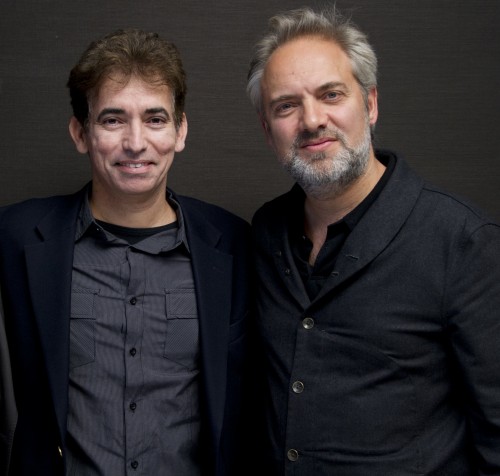
Unlike theatre, which is confined to a stage and hence often limited to exploring mainly inter-personal conflicts, cinema is able to drop its characters into different environments whether it’s on earth or space, expanding the scope of conflict and drama.
Since its inception, cinema has ventured to distant lands, the oceans’ abyss and faraway galaxies, reimagined the past and dared to explore the future, and it has even inspired new scientific discoveries. Nonetheless, theatre still remains a formidable and prestigious art of storytelling, and even produced some of the best performers and directors in the world of film. One of them is British Oscar-winning director Sam Mendes, who tells me when I meet him at the Meridien Hotel in New York that Theatre and Cinema are two completely different beasts. “It’s two different parts of my brain,” he says.
Mendes began directing plays in his early twenties at Cambridge university where he studied English literature. Aged 24, he directed Chekhov’s The Cherry Orchard in London’s West End, starring Judi Dench. Soon, he joined the Royal Shakespeare company, then the National Theatre before he took the helm of the Donmar Warehouse and ventured, as far as Broadway in New York, becoming one of the most prominent stage directors in the English-speaking world.
In 1999, he made the leap into film with American Beauty, which gained him the Oscar for best director. Ironically though, he doesn’t attribute his success in film to his experience in theatre. “There are certain similarities about film and theatre, but there are many more dissimilarities,” he explains. “I mean, there are similarities in that you’re working with actors and you’re working with a script and you’re working with your visual imagination, but it’s a completely different process in so many ways. Filmmaking is so slow, and it’s not organic.”
Indeed, while plays are made in chronological order, enabling the character to grow and evolve as the story progresses forward, film is usually shot nonlinearly in separate segments, which the director assembles later in the editing the room. “You try to put it all together whereas theatre emerges all at the same time,” he adds.
One wonders then, why so many theatre directors end up migrating to making films?
“The joy of movie as opposed to theatre is it’s 360 degrees, whereas in theatre you’re staring at one perspective,” Mendes expounds. “So the joy for me of getting on a set or location with an actor and be able to circle them and find the best place to shoot them from. It’s a huge gift for a movie director coming from theatre.”
Hence, theatre is commonly regarded as a playwright and actor’s medium, whereas, with its vast reservoir of technical tools and visual techniques, cinema offers the director limitless powers and full control over his creation that he could only dream about on the stage.
One of the filmmaking aspects that Mendes finds liberating is the ability to capture an actor doing several shots in different ways and then choose the propitious performance in the editing room. In contrast, actors repeat the same stage performance that was agreed on in rehearsals for months, and he, the director, can do nothing about it.
Nonetheless, theatre teaches its directors how to sustain audience’s commitment for two hours or more, by changing the rhythm of the evening and by learning to tell a story.
“That’s very important in an era where commercials and music video directors get to direct movies often,” Mendes stresses. “They’re brilliant visually but one thing they are not used to is holding an audience’s attention and that’s something that you have to do in theatre without recourse to close-ups, or special effects.”
Thus, it’s not uncommon for theatre directors to surpass other veteran film directors in their cinematic achievements, most notably Orson Welles, whose film Citizen Kane (1948) is still considered one of the best films ever made.
Having excelled in making movies, including the Oscar-nominated Road to Perdition, Jarhead, Revolutionary Road and Skyfall, Mendes turned his attention to TV, producing the BBC series Call the Midwife in 2013, and Showtime’s Penny Dreadful this year.
“TV is where my two parts of the brain (Film and Theatre) meet,” Mendes enthuses. “This is where you’re able to take the time that you would in theatre to develop characters, to let scenes play out over real time, to not rush, to not drive things forward excessively, but at the same time, also to use everything you know about shock tactics and surprises and narrative twists and dramatic cuts that you learn from movies.”
In spite of the differences, in terms of creative methods, presentation and level of control, among these mediums of storytelling, Mendes finds them equally fulfilling as an art of self-expression. “When I finish a play, I can’t wait to start a movie and when I finish a movie, I’m desperate to do a play again, although these days I just feel like all I need is a holiday,” he laughs.
Who could blame him? Other than producing Penny Dreadful, the 48-year-old director helmed three major plays in the last couple of years, Richard III (2012), Charlie and the Chocolate Factory (2013) and King Lear (2014). These days, he is preparing for the next Bond movie.
